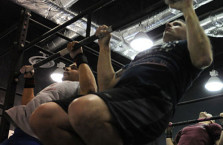We ran across this this article from Fitness Magazine and found it very useful! This shows us how to keep powered up all day long!
Your Energy Makeover Begins Now
I’d just finished shaking the last drops of coffee from an upside-down mug into my mouth when I felt an overwhelming urge to cry. It was 7 a.m. on a busy Tuesday, and I’d already blown through my entire energy strategy for the day. How was I going to survive the next 15 hours of deadlines, meetings, and three go-go-go kids?
Turns out I’m not the only woman who feels exhausted before her day starts. Jennifer Boisture, MD, a psychiatrist at Brigham and Women’s Hospital in Boston, has built a private practice catering to highly successful women, who, like most of us, are trying to juggle it all. “The primary complaint I hear is that they’re tired all the time,” Boisture says. “They’re fit, health-conscious women, but they still need more energy. What they’re doing isn’t working.”
Part of the problem, experts say, is that we have set the energy bar so high. “We have an increasing expectation that we can keep squeezing more and more out of our lives if we can just find the right formula,” says Mark Liponis, MD, medical director of Canyon Ranch Health Resorts. “That kind of pressure is unrealistic and overwhelming and can actually have the reverse effect, of draining your energy.” Another zapper: technology. According to a study in the Journal of Experimental Psychology that compared single- and multitaskers, focusing on one chore at a time is more energy efficient. So reading your iPad on the treadmill or sending texts on your cell while banging out work e-mails on your laptop will drain your brain faster than doing each task by itself.
And yet…you have an 8 a.m. meeting and a 7 p.m. dinner reservation, and you have to pick your daughter up at soccer practice at five — which leaves 6 a.m. as the hour to squeeze in a sweat session. So what’s an energy-starved gal to do? Whether you’re training for a marathon or your day simply feels like one, these totally fresh lifestyle tweaks will do more for your mojo than a 7 a.m. cup of joe ever could.
Step 1: Boost Your Brain — Turn Off the Tube

If your typical fix for end-of-day exhaustion is to plop down on the couch for a dose of Seinfeld reruns, you’re not alone. Most people think that watching TV is a restful activity, but it may not be, says Marc Berman, PhD, a neuroscientist at the University of Michigan in Ann Arbor. In fact, television itself can be tiring, and the older you get, the fewer and fewer stress-reducing benefits you get from a session with the boob tube, a University of California, San Diego study says.
Instead of numbing your mind as a way to rejuvenate, stimulate it. Take a walk along a scenic trail; spending time in nature helps restore people’s energy and focus, a 2008 study in Psychological Science found. What to skip when you’re low on energy? The mall. You’ll get more mental stimulation than you bargained for, which will leave you exhausted.
Step 2: Avoid the Quick Fix
It’s no surprise that the food on your plate can be the deciding factor between a sluggish and a supercharged day. But more often than not, you don’t need a total diet overhaul; small adjustments can go a long way toward optimizing your energy intake, says Ashley Koff, RD, a nutritionist in Los Angeles and FITNESS advisory board member. For starters, don’t ditch caffeine. “A small cappuccino, tea with honey, and dark chocolate, all of which contain caffeine and sugar, are perfectly legitimate ‘energy Band-Aids’ when you need a lift in a hurry,” Koff says. “The trouble comes when people rely on them daily. Spiking and plunging blood-glucose levels create an unhealthy cycle of energy highs and lows.” What’s more, the fluctuating glucose leads to murky decision making, according to a recent study from the University of South Dakota: When participants were asked whether they’d rather receive a small amount of money immediately or get a much larger amount later, those with lower glucose levels were more likely to seize the smaller sum. Clear thinking, scientists conclude, is helped by a constant glucose supply.
Another mistake: too much of a good thing. “Women think they’re making a smart choice by having a healthy turkey, lettuce, and tomato on whole wheat sandwich and a piece of fruit for lunch,” Koff says. “But three hours later they’re at their desks in an energy slump, and they can’t figure out why.” You have to spread the health wealth, Koff says, because your body can use only so many nutrients for energy at one time, meaning a portion of that healthy lunch was used to fuel your body; the rest of the protein and carbs went to energy wasteland. Instead, “have your fruit with some nuts midmorning, then eat half your sandwich at noon and the other half at 3 p.m., when you start to feel sluggish.” You’ll keep a steady stream of nutrients flowing into your blood, holding the snack attack at bay.
And finally, when it comes to boosting energy, a carb is not a carb is not a carb. When people with type 2 diabetes ate white bread for breakfast in a University of Toronto study, they fared worse on verbal-memory and other cognitive tests than those who consumed low-glycemic foods, like pasta. To give your morning a lift, try toasting a whole-grain muffin and spreading a tablespoon of filling peanut butter on it or eat it with a scrambled egg.
Step 3: Stick to Your Workout Routine

Get this: Expending energy on exercise actually creates more for you to use. “Research shows that physically active people feel more energetic overall than sedentary people,” says Patrick O’Connor, PhD, director of the University of Georgia exercise psychology laboratory in Athens. In one Australian study of 40,000 women, the more weekly physical activity they did, the more they reported feeling revved up. “It’s likely that exercise stimulates neurotransmitters, such as dopamine, and this creates feelings of greater energy,” O’Connor says. Aim for 20 to 40 minutes of cardio four or five times a week.
On the other hand, not all workouts need to be heavy-breathing sessions: Yoga is also restorative. A University of New Mexico study found that people who followed an eight-week yoga and meditation program had a significant increase in daily energy. And women who regularly practiced Hatha yoga had 41 percent less cytokine interleukin-6, a compound related to stress, in their blood than those who did not, researchers at Ohio State University found. “Because of the type of deep breathing that’s incorporated into yoga, when you do even a single pose you bring freshly oxygenated blood to your organs,” says Mary-Ann Mastreani, a yoga instructor in Irvington, New York.
For an instant pick-me-up, try performing this Easy Energy Twist at the office or in your living room:
Sit on the edge of a chair, back straight, feet flat on the ground. Inhale as you raise your arms over your head (a); exhale and bring your left hand to your right knee and your right hand slightly behind you on the chair (b). Twist to the right. Sitting tall, inhale and exhale while gently increasing the twist. Relax; switch sides. “Twisting increases blood flow and stimulates digestion, temporarily speeding up your metabolism and increasing energy,” Mastreani says.
Step 4: Listen Up
“Music makes you feel good mentally and physically,” says celebrity trainer Jim Karas, author of The 7 Day Energy Surge. “Research shows it can reduce anxiety, lower blood pressure, and decrease stress hormones, and that it may increase feel-good hormones and improve your fitness performance.” College students zipped through a series of cognitive tasks when listening to upbeat music in a recent study from the University of Dayton. And after people worked out to music, their mental performance improved, compared with exercising song-less, researchers at Ohio State University found.
“Music gives you that extra motivation,” Karas says. “If it’s dark outside when I have to get out of bed, I crank up the music to make myself more alert.” In the morning, choose something peppy — think Beyonce or the Black Eyed Peas — because your mind needs a positive nudge, not an angry blast of heavy metal. In the evening, give Mozart a try. People with sleep problems who listened to classical music for 45 minutes before bed snoozed more soundly than those who didn’t, according to researchers in Budapest. What’s sleep got to do with energy? Plenty. Scientists at the University of California, San Diego discovered that skipping a night of sleep significantly impaired cognitive abilities in people in their 20s and 30s. “When clients tell me they need only six hours, I tell them that they’ve trained themselves to live on that,” Karas says. “But if they got more, they’d see a huge improvement in their energy.”
Step 5: Quit Freaking Out

It’s ironic that one of the biggest energy consumers of our day has nothing to do with packed schedules or sweaty workouts. Little everyday stressors, like sitting in traffic, can cause a total energy meltdown. “Not at first,” explains Kimberly Kingsley, author of The Energy Cure, “because your initial reaction to stress is that your body starts pumping the hormone cortisol into your bloodstream, giving you an adrenaline rush.” Your heart rate rises, your muscles tense, and your mind goes on high alert. But the rush is unsustainable, and before long your energy starts to crash, leaving you feeling foggy and unfocused.
In fact, 76 percent of people in the United States feel the physical symptoms of stress, including fatigue, according to a recent survey by the American Psychological Association. “The minute anxiety causes your heart to start racing and your breathing to become shallow, begin taking deep, deliberate inhales and exhales,” Kingsley says. “Focus on breathing in and out until your heart rate goes back to normal.”
Step 6: Tap Happy Vibes

When you’re feeling down, your energy tanks along with your spirits, leaving you sluggish. On the flip side, “Happy people have higher energy,” says Sonja Lyubomirsky, PhD, author of The How of Happiness. When researchers at the University of California, Riverside asked people to keep a journal of their feelings, those who reported the greatest number of positive emotions also reported having the most energy day to day. “When we’re happy, we take charge, initiate conversations with people, and carry out plans, instead of being passive responders to life events,” Lyubomirsky says. “Taking action energizes us.” Pump up your own positive thinking by jotting down five things you are grateful for, she suggests. Reread your list when you need a smile. For a double dose of happiness, practice random acts of kindness throughout your week. Open the door for the person behind you at the grocery store or compliment a colleague on his or her work. Generosity toward others makes you feel happier inside today and revved up to take on the world tomorrow.
Instant Energy: 3 Get-Up-and-Go Tricks
Surprising tweaks that deliver big results. Try ’em now!

Have a glass of water. Staying hydrated is one of the easiest things you can do for energy, says nutritionist Ashley Koff, RD. When you skimp on water, the cells in your body shrink, so they can’t function as efficiently, triggering feelings of fatigue.
Talk fast. Ever notice that energetic people tend to zip through their words? Fast talk means fast thinking, which automatically boosts your energy, says Emily Pronin, PhD, associate professor of psychology and public affairs at Princeton. Speed-talk your way through your next friendly chat, and feel that breathless rush give you a boost.
Practice self-forgiveness. No more “I’m worthless because I’m overweight” or “I’m a lazy slob for skipping my workout” thoughts. “Guilt is like glue,” says Kimberly Kingsley, author of The Energy Cure. “It keeps you stuck in a low-energy rut.” Just. Stop. Now.





![Morning Kick Start Tips! [VIDEO]](http://FitPhreak.com/wp-content/uploads/2016/06/morning-tips-223x145.jpg)







